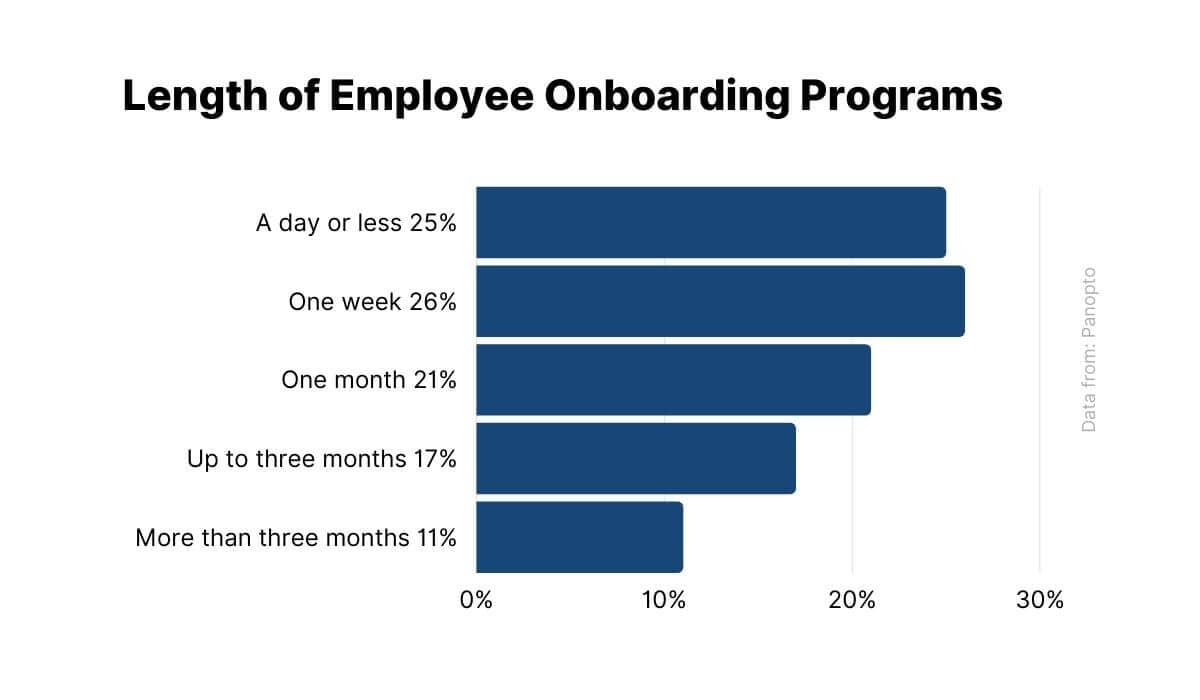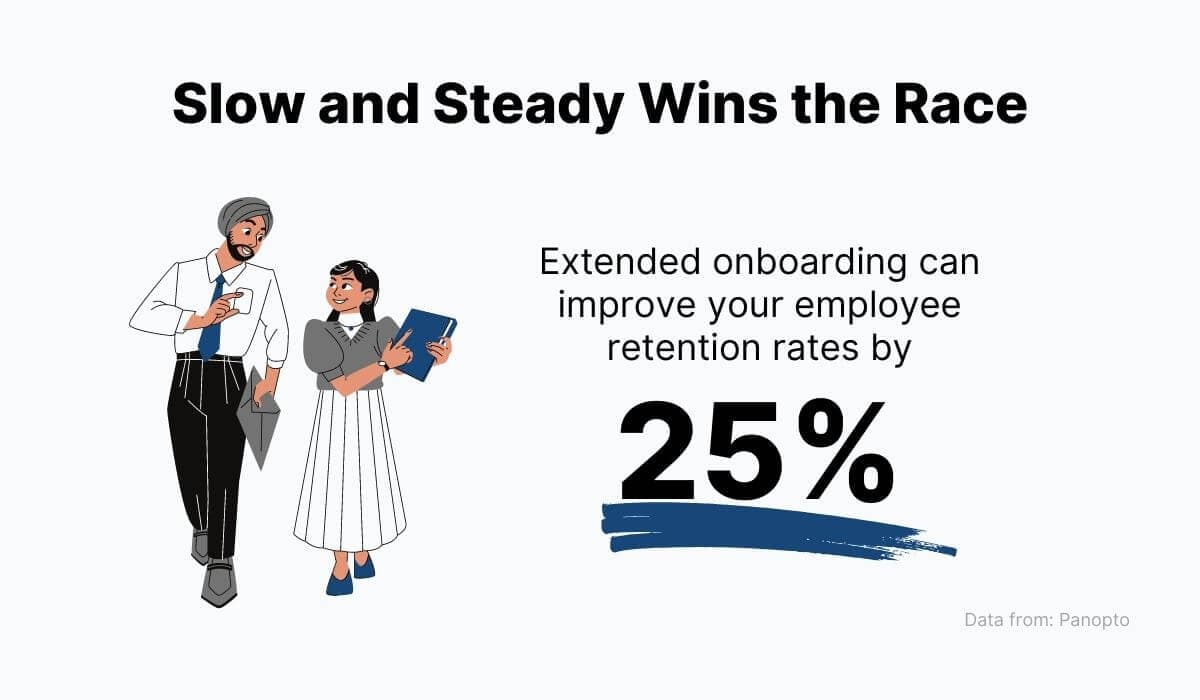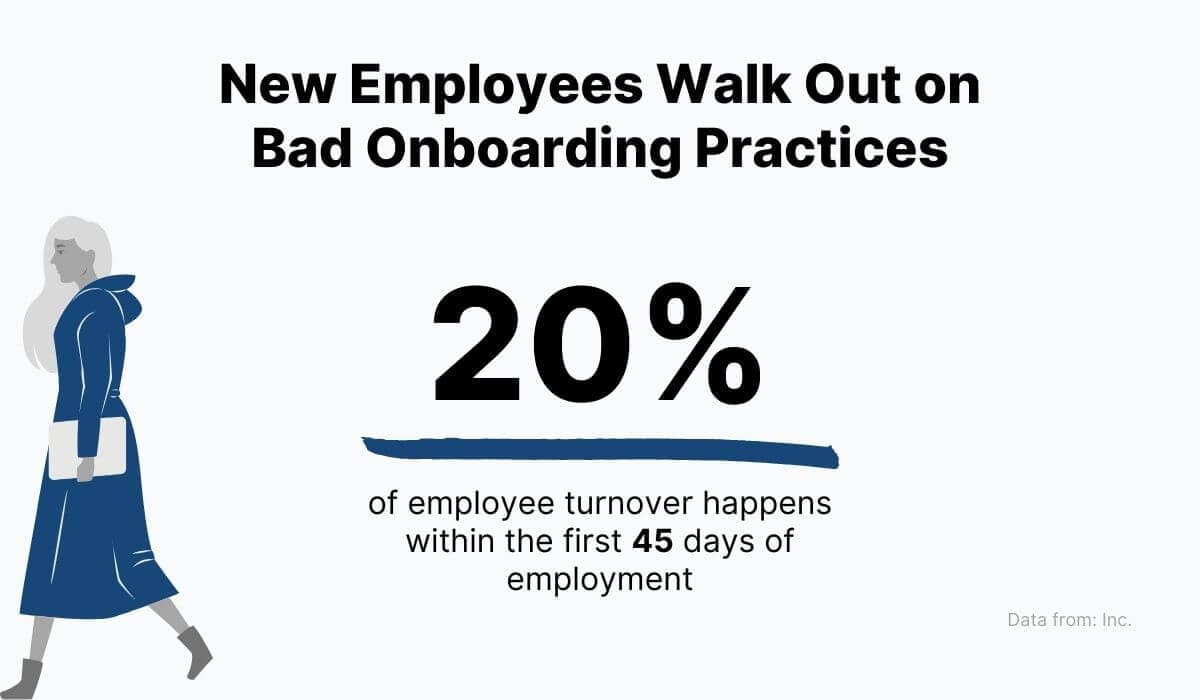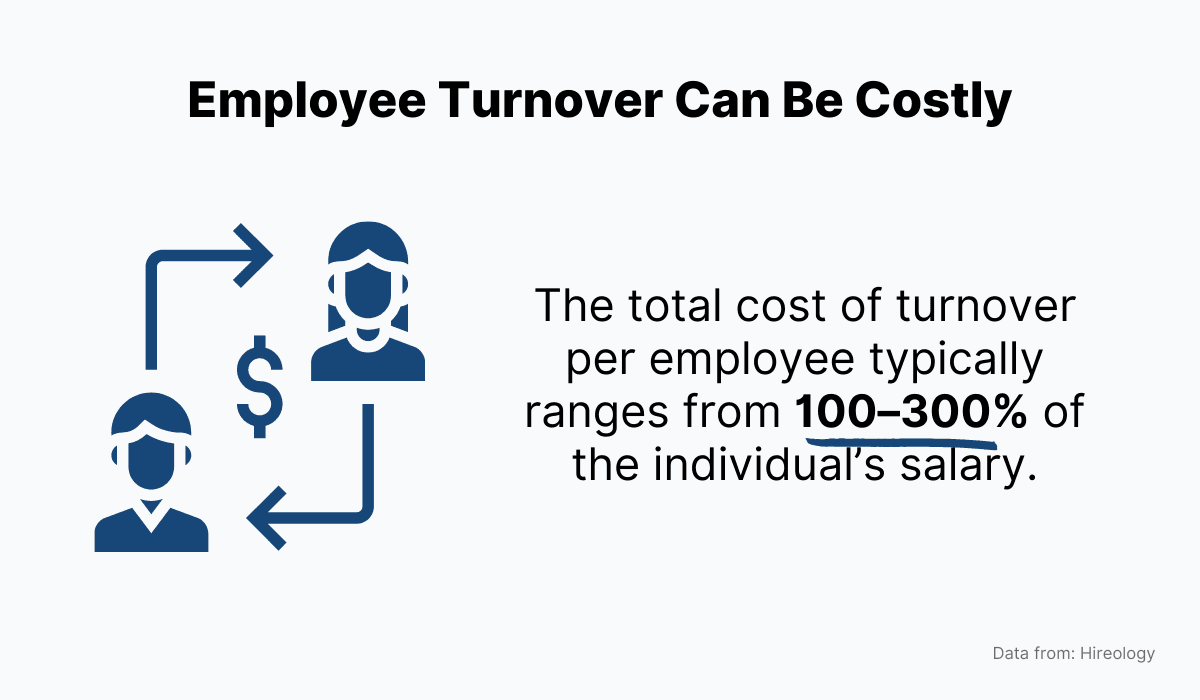A worrying statistic tells us that as many as 88% of employees are unhappy with how their employer handles the onboarding process.
For many of these workers, the root of the problem lies in the fact that their companies don’t take enough time to welcome new recruits into their ranks, which leaves them feeling ill-equipped for the challenges of their jobs.
That’s why, in this article, we’ll discuss how long onboarding new employees should really take.
And while there is no straightforward answer to this question, we hope the advice we offer will convince you to invest more time into helping your new hires become high-achieving members of your team.
Let’s start with some basic benchmarks for employee onboarding.
Employee Onboarding Time Benchmarks
If you’re looking for a definitive timeframe for your onboarding process, you should know that there really isn’t one.
The time it takes to onboard an employee will necessarily depend on a number of factors, such as the industry you’re working in and the new employee’s role.

Source: Archbee.com
If you think about it, it’s only logical.
A c-suite executive will need more time to catch up on the complexities of the company, while a lower-level employee will need less time as their role has a smaller scope.
Of course, there’s also a variety of roles between them, each with a different level of responsibility and required experience.
That being said, common sense dictates that onboarding should take long enough to produce happy and productive employees who are able to work independently and without constant supervision.
Obviously, that can’t happen overnight.
Unfortunately, many employers still don’t understand that onboarding takes time and effort, which is evidenced by the wildly different timeframes companies give their onboarding programs.

Source: Archbee.com
As you can see above, more than half of onboarding programs don’t last beyond the first week, which HR experts agree is definitely not enough time to prepare employees for the challenges of their new job.
In fact, while there’s no formal consensus on this matter, HR experts usually recommend onboarding between three months and up to an entire year!
For example, Michael Watkins, a leading expert on onboarding, has written an entire book titled The First 90 Days.
The book, in a nutshell, explains that the first three months are the period when you can make the biggest impact on your new employee and influence their productivity and your chances of keeping them on in the long term.
Going beyond Michael Watkins, some experts point to the fact that research has shown that the majority of employee attrition happens during the first six months on the job.

Source: Archbee.com
The logical conclusion is that onboarding should work towards carrying the new employee through this sensitive period in order to retain them after the onboarding is over.
Finally, there are experts who argue for a yearlong onboarding process because, as humans, we need ample time to form meaningful, deep relationships with others in our environment.
Employee onboarding should be a highly social process that builds networks and relationships in the workplace, instead of a transactional event that just shows new employees where everything is.
In conclusion, how long should employee onboarding take?
❎Days? No.
✅Months? Yes!
The following sections will explain in more detail why longer onboarding programs are more effective and how to prevent going overboard with onboarding.
Benefits of an Extended Onboarding Process
We already broached this subject by saying that extending onboarding beyond the first month can help employee retention and allow for natural network building.
So, let’s take a closer look at the benefits of taking your time when it comes to employee onboarding.
The first benefit we need to talk about here is massively improved employee retention.
Allowing enough time for new recruits to settle in is a great way to help them relax and find their footing.
The more knowledge you manage to transfer and the more you facilitate relationship building between the new hire and your existing team, the more your new employees will feel like they belong at your company.
Knowing everything they need to know about their role, your employees are much more likely to achieve success and contribute to your company in more meaningful ways.
It, therefore, comes as no surprise that extended onboarding gives your employee retention rates a massive boost.

Source: Archbee.com
Furthermore, extended onboarding gives you a chance to break up the knowledge you need to transfer into more digestible chunks.
Realistically, no one can be expected to absorb every detail of a complex professional role in a week or two.
A much better approach is to space the information between a number of months with checkpoints tied to specific goals set up along the way.
Here’s what that could look like within an onboarding process that takes a whole year:

Source: Archbee.com
As you can see, there’s plenty to do, even after basic training is completed.
Moreover, expanding the onboarding process also gives you an opportunity to instill and develop skills in your new employee that go above and beyond the basic training needed for work.
This includes technical knowledge and soft skills that will allow this employee to excel at their role and, hopefully, one day become a leader at your company.
All in all, extending your onboarding process is one of the best steps you can take to improve the state of human resources at your company.
So don’t be afraid to take your time and focus on onboarding new employees for a longer period of time, maybe even an entire year.
How Short Onboarding Affects Retention
Now that we’ve examined the benefits of extended onboarding, let’s also look at the opposite case and ask a very important question: can a short onboarding period harm your business?
Unfortunately, the answer is yes.
Employers who treat onboarding as a transactional event—that is, a short process that mainly deals with signing contracts and reading paperwork—face the biggest risk of putting off their new hires.
In other words, they risk losing them shortly after they join the company.

Source: Archbee.com
That’s because workers are looking for more than a paycheck in today’s corporate landscape.
Of course, being able to make a living still takes precedence, but employees have a desire to learn, develop their skills and advance their careers.
And if their employer isn’t able to give them that, they are more than willing to try their luck elsewhere.

Source: Archbee.com
“Their loss,” you might say. But actually, high employee turnover can be devastating for employers.
In today’s labor market, opportunities abound for young, educated professionals, while the resources you’ve invested into recruitment and training can’t be made back.
Let’s explain that a little further.
Finding employees has almost never been more difficult, so recruitment costs are already very high.
Add to that the costs, time, and effort it’s taken you to train the new employee (even if onboarding was kept short), and you may be quite shocked to see that the cost of losing your employee is greater than their original salary!

Source: Archbee.com
And if you think about it, turnover actually costs you more when you lose a new employee, compared to a veteran at your company.
That’s because new employees never actually got the chance to contribute to your company.
More seasoned workers, on the other hand, have brought a return on your investment in their hiring and training, many times over.
That’s quite a twist, isn’t it?
Many employers today believe onboarding to be too costly and not really worth the effort.
However, the hard truth is that you can’t afford not to onboard your new employees properly and effectively because you stand to lose much more.
Longer Onboarding Duration Allows for Relational Onboarding
In addition to regarding onboarding as a single transactional event, instead of a lengthy process, another misconception about employee onboarding is that its purpose is to just train workers on the specifics of their job.
But employee onboarding, when done right, is much more than signing paperwork, providing an employee handbook, and giving the new recruit a tour around the office.
Your employee onboarding process is a chance to slowly integrate your new hire into the unique culture and experience that is your company. And that takes quite some time.
In essence, this means that multiple players need to be brought together to carry the recruit through the onboarding process.

Source: Archbee.com
All of these people should participate in the mental support, socialization, and knowledge sharing that make up a strong employee onboarding process.
Why is it important to structure onboarding in this way?
Because it’s going to have a direct impact on the performance of your new hire, and therefore also on the productivity levels of your entire enterprise.
This sounds logical in itself, but the correlation between relational onboarding and enhanced performance has actually been proven by research.
For example, a newcomer adjustment study undertaken in India in 2017 showed that new employees seek out information and ask more questions when they feel connected to other people at the company.
Similarly, research has shown that companies that exhibit signs of cut-throat culture and merciless competition most often fall behind companies that nurture positive relationships.
Just ask Emma Seppälä and Kim Cameron, authors of the HBR article Proof That Positive Work Cultures Are More Productive, who claim that:
“A large and growing body of research on positive organizational psychology demonstrates that not only is a cut-throat environment harmful to productivity over time, but that a positive environment will lead to dramatic benefits for employers, employees, and the bottom line.”
Interconnected workplace, positive company culture—these are some of the highest values companies can strive for, and it all starts with an extended, carefully planned, relational onboarding process.
And you can bet that the most successful companies out there leverage this fact every day.
Take Google, for example.
Google employs some of the smartest, most capable people in the world who literally perform miracles for the company on a daily basis.

Source: Twitter
How does Google empower its employees to do their best work? By supporting them at all times during onboarding, of course.
The person who owns a new hire’s onboarding process is their manager.
And before every Noogler starts working, their manager goes through a standardized checklist that puts the employee in contact with several key people at the company and establishes the foundations for continuous communication.

Source: Google Twitter
This kind of relational employee onboarding is one of the secrets to Google’s success.
So take a page from their book and make your onboarding relational, rather than transactional.
Even if it takes longer to complete.
How Automation Makes Onboarding More Effective
Over the course of this article, we’ve argued enthusiastically for a longer, more patient onboarding process that integrates new hires into a way of life at your company, rather than just a position.
We stand firmly by our words; however, we do realize onboarding can’t take forever.
Sooner or later, your new hire is going to have to become an independent, high-achieving member of the team who doesn’t need you holding their hand as they carry out their tasks.
That’s why we’re ending this article with advice on how to shorten time to productivity for new employees, without sacrificing the quality of your onboarding program.

Source: Archbee.com
Obviously, having a short but effective onboarding process would be ideal. Unfortunately, as this article has illustrated, that’s largely unattainable.
However, what you can do is experiment with your onboarding program until you find the shortest possible process that still yields the desired results.
Automation and technology can help you a great deal in this quest.
To start with, you can automate onboarding related-activities using onboarding software such as bob or bambooHR.
Let’s check out how BambooHR helps companies onboard their employees in no time.
As you can see, onboarding software can help you speed up the process with features like:
- Automated tasks (by job title, department, location)
- Automated preboarding (paperwork, get-to-know-you surveys)
- Progress tracking
- Onboarding checklists for managers
Can you imagine how much time that could save?
The best part is, this also gives your onboarding process an effectiveness boost because it keeps the employee engaged and on track, even when their manager isn’t around to work with them.
But this kind of onboarding software helps automate tasks, activities, and paperwork more than anything else. What about the learning process that’s so integral to onboarding?
Well, there’s a lot you can do to automate that as well.
For example, you could give your new hire access to your knowledge library.
There, they can find all the information they need during the onboarding process, such as the company policy, code of conduct, employee handbooks, product guides, and so on.
That way, they can learn about your company independently, and at their own pace.
They’ll have everything at their fingertips, rather than being forced to chase documents down and ask people around the company to give them access.
If you still don’t have a knowledge library, you can use quality documentation software, like Archbee, to build one and make it available to everyone who needs the information contained within.

Source: Archbee.com
With a good knowledge base at their disposal, employees can handle more situations on their own because they can always look up procedures and guides.
Plus, with so much knowledge available, they can get answers to a lot of questions they would usually feel nervous about asking. That also makes your onboarding process more effective.
Remember, it’s quite alright to automate tasks.
Don’t hesitate to use any tools at your disposal to make work processes more effective and time-efficient.
Especially if those processes don’t need a human touch.
One thing you shouldn’t try to automate is your new employee’s social contacts and interactions with their colleagues and managers, as these relationships need to form naturally.
Conclusion
So there you have it. There’s no definitive answer to the question “How long should employee onboarding take?”
The best advice we can give you is to take your time with your employee onboarding process.
That’s the best way to ensure your new employees can find meaning in their new role and become the best possible person to fill the role you have assigned them.
It may take some experimenting to find the right formula, but once you do, your onboarding process will become the driver of productivity, happiness, and success at your company.
FAQ
Frequently Asked Questions
Great onboarding does more than show someone where things are. It gives people clarity, confidence, and connections—fast.
Here’s what effective onboarding delivers:
- Role clarity: Clear goals, success metrics, and what good looks like.
- Enablement: Tools, systems access, processes, and a searchable knowledge base.
- Relationships: Regular manager 1:1s, a buddy or mentor, and cross‑functional intros.
- Culture immersion: How decisions get made, values in action, and ways of working.
- Feedback loops: Frequent check‑ins and timely coaching.
The payoff: lower anxiety, faster time to productivity, and stronger engagement—especially critical in the first six months when attrition risk peaks.
Quick starter checklist:
- What I own (responsibilities and outcomes)
- How I do it (processes, tools, help docs)
- Who helps me (manager, buddy, key partners)
- When we check in (cadence for feedback and goals)
